Best Implant Dentist In Delhi

The primary mission of Dental Works has been to provide all kinds of dental treatments under one roof.
Who is an Endodontist?
Endodontic is a distinctive branch of dentistry that deals exclusively with the nerves or roots of the teeth, hence, an endodontist is commonly known as root canal dentist.
Dr. Simran Kaur, a gold medalist endodontist, is one of the best root canal specialists in Delhi, well known for her expertise in this field.
What is Root Canal Treatment?
Root canals are probably the most notorious procedure in dentistry and the most common procedure relating to endodontics. When a tooth becomes infected it is usually related to the nerves in the root of the tooth. The infected nerves need to be removed. If left untreated an infection can turn into an abscess, which is a much more serious problem that includes bone loss in the jaw.
The area around the tooth is numbed with a local anesthetic to start the procedure. The dentist will then drill down into the tooth to create an opening into the canal. They will then be able to remove infected tissue and clean the canal. After the infection has been removed, space if filled with a sealant called gutta-percha. It is highly recommended that a tooth that has undergone a root canal is fitted with a crown. This will improve the appearance of the tooth, and will also make it much more likely that the root canal is successful.
“Root canal” has become a scary term for dental patients to hear, but the benefits of the procedure and advances in dental technology have made it much less “scary”. Local anesthetics and proper pain medication allow the procedure to be performed with little to no pain in most cases. There may be some soreness following the procedure, but that is normal for most dental procedures. Over the counter, painkillers are usually enough to relieve any pain afterward, but your dentist may prescribe medication. The procedure will also relieve you from pain caused by the infection allowing you to enjoy all the foods you love without any pain from heat, cold, or biting too hard. If you are experiencing pain consult your dentist today.
Dr. Simran is a highly skilled smile design and root canal specialist and all cases of root canal treatment at Dental Works are performed under her able guidance. She is also one of the best root canal specialists in Delhi.
What is Root Canal Treatment?
A root canal treatment is a dental procedure that is used to treat dental pain or infection caused by the inflamed or dead nerve, a condition called pulpitis.
Root canal treatment specialist uses specific tools and techniques to reach deep into the tooth, removing inflamed nerve and debris before sealing the canal and applying a filling. Removal of the infected nerve stops the pain and further development of the infection. If left untreated the infection surrounding the tooth will eventually cause loss of the tooth.
When Do I Need a Root Canal Treatment?
If you experience any of the symptoms described below we would recommend you see a dentist for an evaluation because you may need a root canal treatment:
- If you have a tender or swollen gum
- A tooth that is painful especially when touched
- If your tooth is sensitive to hot and cold
- A tooth that is damaged
- If you experience throbbing pain
Best Root Canal Specialist in Delhi
The need of root canal treatment arises when the roots of a tooth get infected. If you are on the lookout for the best root canal specialist in Delhi, then Dental Works is the most promising place to contact.
The procedure involves steps that, Dr. Simran, who is an RCT specialist in Delhi, can efficiently perform.
What causes damage to Root Canal?
There are a number of reasons why one may end up with a root canal treatment. The most common causes of needing root canal treatment are:
- Large caries and deep recurrent decay (developed under an existing restoration) close to the nerve
- Nerve damage due to physical trauma (i.e. fall from a bike)
- Nerve damage due to sinus infection
- Large filling or other restoration may cause sensitivity to the nerve
Root Canal Procedure
As a root canal specialist, Dr. Simran practices Endodontics and performs following procedures Root Canal Treatment, Root Canal Retreatment, Emergency Root Canals, core build-ups, pain management, removal of broken instruments from old root canals and internal bleaching.
If you are in need of a professional opinion of a root canal specialist please book a consultation with Dr. Simran.
- Severe toothache that may be a dull, constant throbbing or sharp pain when biting down
- Dental sensitivity that lingers following exposure to heat or cold
- Discoloration of the tooth, usually dark coloring near the gum line
- Inflammation or infection in the gum tissue
- Other signs of infection, including fever
Do I Need a Root Canal Crown?
The crown or another type of dental restoration is required to complete the care of the compromised tooth. As a specialist, Dr. Simran will do the restorative part of the treatment, i.e. crown or any type of filling.
Root Canal Treatment Steps:
- An X-Ray is taken to determine the level of infection & damage.
- Local anesthesia applied to numb the affected area.
- The tooth will be opened to access the root canals.
- Infection is cleaned & the unhealthy pulp removed.
- The canals are filled with gutta-percha.
- A temporary filling is applied to seal the opening.
- After a few days, a crown is placed on the tooth.
The recovery time for a treated tooth takes a few days in which the pain subsides but the patient should be careful of not chewing hard things until the healing process is complete.
Dr. Simran has performed the most complicated of such surgeries and is an acknowledged RCT specialist in Delhi.
Root Canal Recovery
 Immediately after the root canal treatment, the area around the tooth may be sore, so you may want to avoid biting down or using that tooth. In general, though, you can care for your tooth like any other tooth, with regular brushing and flossing.
Immediately after the root canal treatment, the area around the tooth may be sore, so you may want to avoid biting down or using that tooth. In general, though, you can care for your tooth like any other tooth, with regular brushing and flossing.
Immediately following your root canal, you may want to avoid chewing on that side of the mouth and take extra care when brushing and flossing around the tooth, which may be sensitive for a few days after your root canal. Once the minimal irritation or inflammation subsides, you should be able to brush and floss as usual. If you have a porcelain crown protecting your root canal treated tooth, you may want to switch to a softer toothbrush and minimally abrasive toothpaste to avoid excessive wear. Using a waxed floss may also be beneficial to avoid snagging or pulling around the crown.
Consult Dental Works for taking treatment from the best root canal specialist in Delhi, that too, in the most cost-effective way!
Crowns and Bridges
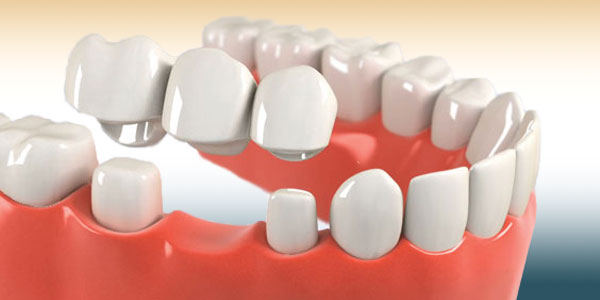
When a tooth has become injured, decayed, weakened, incomplete, or even completely missing, it’s important to restore the missing structure as soon as possible for the sake of the patient’s oral function and self-confidence. Our practice offers custom-made dental crowns and bridges as durable methods for recreating teeth that can be wholeheartedly relied on. Better yet, we use materials of the highest quality (including tooth-colored dental porcelain) to ensure results that exceed expectations.
Crowns and bridges are a fixed solution to missing or damaged teeth. A crown is used when the tooth structure is damaged or fractured. A bridge is used when one or more teeth are missing.
They are required in the following areas:
- Replace a large filling when there isn't enough tooth remaining.
- Protection of any weak tooth from fracturing.
- Top Restore a fractured tooth.
- To Cover a dental implant.
- To camouflage a discolored or poorly shaped tooth.
- To give strength to a root canal treated tooth.
- Bridges are commonly used if you’re missing one or more teeth. They cover the space where the teeth are missing and are cemented to natural teeth or implants surrounding the space.
Porcelain Crowns
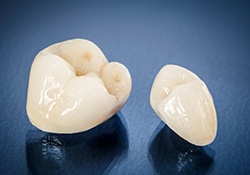 A broken or cracked tooth can be more than just an eyesore. It can cause sudden pain (especially when eating) or result in constant discomfort. A damaged tooth can also have more significant implications for the way the upper and lower teeth fit together when the patient bites down. Dental crowns are typically utilized at our Dental Works practice in these cases. Dr. Simran Kaur places crowns over the damaged teeth to protect and support them, as well as restore the appearance of the smile. If you are experiencing pain from a broken or cracked tooth, contact the team at Dental Works today to schedule an appointment to discuss the placement of a porcelain crown.
A broken or cracked tooth can be more than just an eyesore. It can cause sudden pain (especially when eating) or result in constant discomfort. A damaged tooth can also have more significant implications for the way the upper and lower teeth fit together when the patient bites down. Dental crowns are typically utilized at our Dental Works practice in these cases. Dr. Simran Kaur places crowns over the damaged teeth to protect and support them, as well as restore the appearance of the smile. If you are experiencing pain from a broken or cracked tooth, contact the team at Dental Works today to schedule an appointment to discuss the placement of a porcelain crown.
About Porcelain Crowns
A porcelain crown is a tooth-shaped covering that is placed over the surface of a damaged tooth to provide normal appearance and function. Crowns are made from tooth-colored material that is shaped to resemble natural teeth, making crowns virtually undetectable from surrounding teeth. Crowns are commonly used to support single teeth but may also be used to hold a dental bridge in place. Crowns frequently top dental implant posts as well; when a tooth has fallen out or been extracted, a dental implant provides an excellent, stable base for the crown.
The Placement of Porcelain Crowns
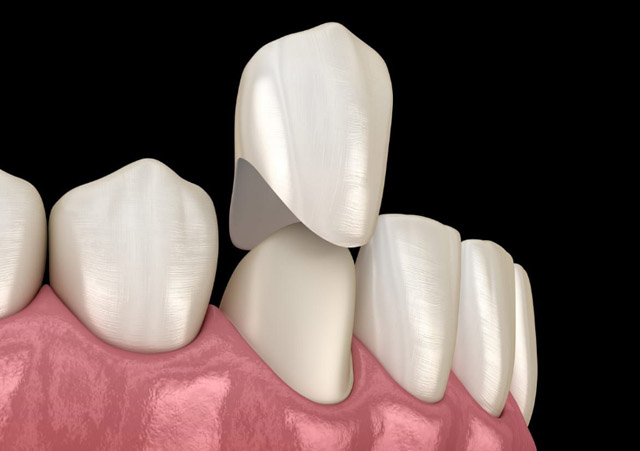 The placement of porcelain crowns usually requires two office visits to Dental Works. During the first visit, we remove the decayed area of the tooth and some additional structure to make room for the crown. She then captures impressions that are used to guide the fabrication of the crown at a dental laboratory. The crowns will be custom-crafted to fit the patient’s teeth and blend in flawlessly with the surrounding teeth’s color, shape, and size. While the custom restoration is being created, Dr. Simran may place a temporary crown so the patient can eat and speak normally.
The placement of porcelain crowns usually requires two office visits to Dental Works. During the first visit, we remove the decayed area of the tooth and some additional structure to make room for the crown. She then captures impressions that are used to guide the fabrication of the crown at a dental laboratory. The crowns will be custom-crafted to fit the patient’s teeth and blend in flawlessly with the surrounding teeth’s color, shape, and size. While the custom restoration is being created, Dr. Simran may place a temporary crown so the patient can eat and speak normally.
Once the custom crown is ready, the patient returns to our office to have it placed. This is usually about two to three days after the initial visit. The temporary crown is removed, and the custom crown is slipped over the tooth and bonded into place with a dental adhesive. The crown is buffed and polished to mimic the appearance of the surrounding, natural teeth, and Dr. Simran checks to make sure the bite lines up correctly.
Benefits of Porcelain Crowns
Porcelain crowns offer several benefits. They are crafted from only the finest materials, making them extremely durable and long-lasting (with the proper care). The porcelain material closely resembles natural tooth enamel, so the crowns will blend in seamlessly with the surrounding teeth. They also restore the patient’s ability to chew normally, although for optimal results, it’s best to avoid extremely sticky or tough foods.
Crowns can save a tooth that otherwise may need to be extracted and replaced with a dental implant. Placing a crown is a much less invasive procedure than placing dental implant posts. Also, placing crowns can improve a bite that is thrown off by a missing or misshaped tooth.
Contact Us about Porcelain Crowns
If you’re interested in the placement of porcelain crowns, please contact our Dental Works office today. A friendly member of our office staff can schedule a personal consultation for you to discuss your needs with Dr. Simran and determine the best course of treatment.
We deal in customized solution to our patients when it comes to crowns and bridges. We take pride in the fact that we ensure that all are prosthetic work is done via CAD – CAM machines with a 3D simulation to give you that exact matching shape and colour. Following are some of the materials that we give our patients when it comes to crown and bridges.
Zirconia / Porcelain- Zirconium is a relatively new material that has the strength of metal and aesthetic properties of porcelain crowns. Zirconia, (zirconium dioxide) is a white, powdered metal oxide. It is made from zirconium, a metal with similar properties to titanium. Zirconium makes a good choice for dental material because it is chemically nonreactive. The main advantages of zirconia crowns are they provide great aesthetics, they are strong and long lasting and are less likely to wear off due to their strength. Disadvantages includes difficulty in adjusting and possible wearing down of teeth they bite against.
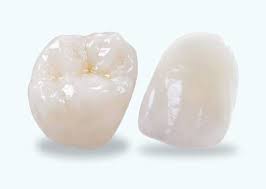 E-MAX crowns – The latest type of crown in dentistry today is as E –Max or Lithium Disilicate Crowns. It is made of lithium disilicate and is a type of all ceramic crown. They provide fantastic aesthetics and durability and are a great choice for front and back teeth. They bring out the unmatched quality of aesthetics in any of the available dental materials. They are a preferred choice for veneers and front teeth caps.
E-MAX crowns – The latest type of crown in dentistry today is as E –Max or Lithium Disilicate Crowns. It is made of lithium disilicate and is a type of all ceramic crown. They provide fantastic aesthetics and durability and are a great choice for front and back teeth. They bring out the unmatched quality of aesthetics in any of the available dental materials. They are a preferred choice for veneers and front teeth caps.
Porcelain fused to metal (PFM) - Porcelain-fused-to-metal (PFM) crowns have been considered the benchmark for the repair of damaged teeth since a long time. They provide great aesthetics and durability and are less costly than porcelain crowns. However, there are certain disadvantages like the crown may cause grey line at the gumline which makes it less aesthetic than all porcelain crowns. For patients with bruxism and clenching habits, this type of crown tends to wear down more easily against the opposite teeth.
VITA ENAMIC – the most versatile and the latest of all crowns is the newest material in dentistry is VITA ENAMIC. Having the same wear strength as of natural tooth, nothing comes close to it in terms of aestheticsand life like appearance. An ideal choice for patients with clenching and bruxing habits – these crowns will not harm the opposing teeth and will wear exactly at the same rate giving more life to your existing dentition. These are the costliest of the crowns.
We take pride in the fact that we are the one of the handful of clinics in INDIA that can provide you with these caps.
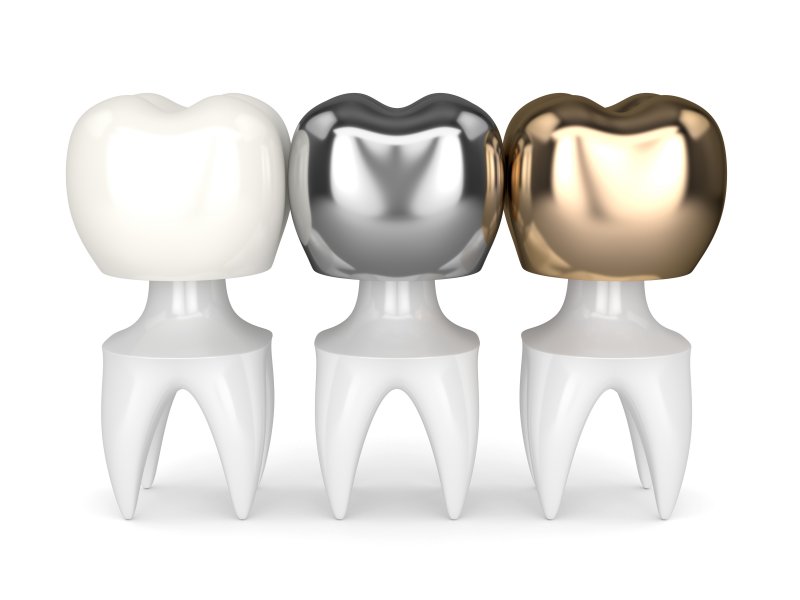 Metal crowns / gold crowns – although obsolete nowdays, we can still get you full jacket metal or gold crowns on demand. They are strong and highly resistant and wear down quite slowly. If properly cared for, they last a long time. Due to difference in color, they have poor aesthetic qualities and can cause metal reactions to certain patients.
Metal crowns / gold crowns – although obsolete nowdays, we can still get you full jacket metal or gold crowns on demand. They are strong and highly resistant and wear down quite slowly. If properly cared for, they last a long time. Due to difference in color, they have poor aesthetic qualities and can cause metal reactions to certain patients.
All our crowns come with minimum 10 years warranty.
You have the option to chose higher grade and premium options which come with superior material strength and increasing warranty.
Dentistry for Kids
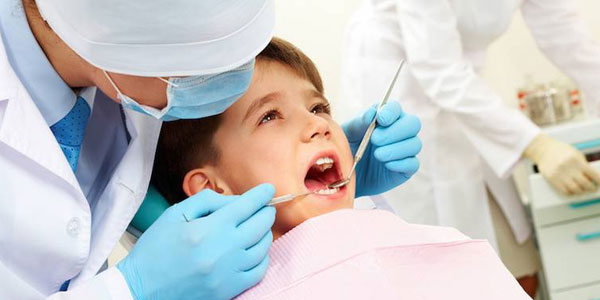
What Is A Pediatric Dentist?
The pediatric dentist has an extra two to three years of specialized training after dental school and is dedicated to the oral health of children from infancy through the teenage years. The very young, pre-teens, and teenagers all need different approaches in dealing with their behavior, guiding their dental growth and development, and helping them avoid future dental problems. The pediatric dentist is best qualified to meet these needs of Pediatric Dentistry.
Why Are The Primary Teeth Important?
It is very important to maintain the health of the primary teeth. Neglected cavities can and frequently do lead to problems which affect developing permanent teeth. Primary teeth or baby teeth are important for (1) proper chewing and eating, (2) providing space for the permanent teeth and guiding them into the correct position, and (3) permitting normal development of the jaw bones and muscles. Primary teeth also affect the development of speech and add to an attractive appearance. While the front 4 teeth last until 6-7 years of age, the back teeth (cuspids and molars) aren’t replaced until age 10-13.
Eruption Of Your Child’s Teeth
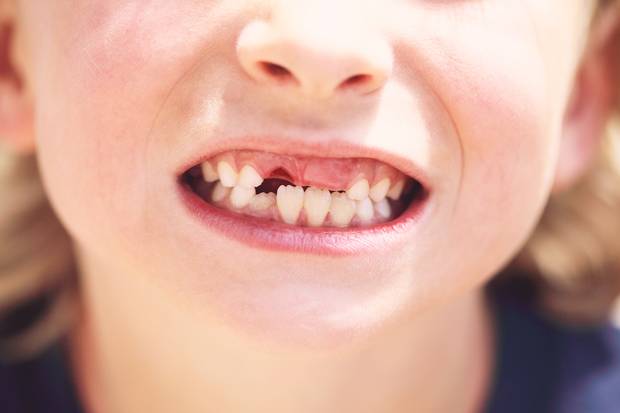 Children’s teeth begin forming before birth. As early as 4 months, the first primary (or baby) teeth to erupt through the gums are the lower central incisors, followed closely by the upper central incisors. Although all 20 primary teeth usually appear by age 3, the pace and order of their eruption vary.
Children’s teeth begin forming before birth. As early as 4 months, the first primary (or baby) teeth to erupt through the gums are the lower central incisors, followed closely by the upper central incisors. Although all 20 primary teeth usually appear by age 3, the pace and order of their eruption vary.
Permanent teeth begin appearing around age 6, starting with the first molars and lower central incisors. At the age of 8, you can generally expect the bottom 4 primary teeth (lower central and lateral incisors) and the top 4 primary teeth (upper central and lateral incisors) to be gone and permanent teeth to have taken their place. There is about a one to two-year break from ages 8-10 and then the rest of the permanent teeth will start to come in. This process continues until approximately age 21.
Adults have 28 permanent teeth or up to 32 including the third molars (or wisdom teeth).
Pediatric Dentistry – Dental Emergencies
Toothache: Clean the area of the affected tooth. Rinse the mouth thoroughly with warm water or use dental floss to dislodge any food that may be impacted. If the pain still exists, contact DENTAL WORKS. Do not place aspirin or heat on the gum or on the aching tooth. If the face is swollen, apply cold compresses and contact your dentist immediately.
Cut or Bitten Tongue, Lip or Cheek: Apply ice to injured areas to help control swelling. If there is bleeding, apply firm but gentle pressure with a gauze or cloth. If bleeding cannot be controlled by simple pressure, call or visit us as soon as possible.
Knocked Out Permanent Tooth: If possible, find the tooth. Handle it by the crown, not by the root. You may rinse the tooth with water only. DO NOT clean with soap, scrub or handle the tooth unnecessarily. Inspect the tooth for fractures. If it is sound, try to reinsert it in the socket. Have the patient hold the tooth in place by biting on a gauze or clean cloth. If you cannot reinsert the tooth, transport the tooth in a cup containing the patient’s saliva or milk, NOT water. If the patient is old enough, the tooth may also be carried in the patient’s mouth (beside the cheek). The patient must see a dentist IMMEDIATELY! Time is a critical factor in saving the tooth.
Knocked-Out Baby Tooth: Contact DENTAL WORKS. Unlike with a permanent tooth, the baby tooth should not be replanted due to possible damage to the developing permanent tooth. In most cases, no treatment is necessary.
Chipped/Fractured Permanent Tooth: Time is a critical factor, contact DENTAL WORKS immediately so as to reduce the chance for infection or the need for extensive dental treatment in the future. Rinse the mouth with water and apply a cold compress to reduce swelling. If you can find the broken tooth piece, bring it with you to the dentist.
Chipped/Fractured Baby Tooth: Contact US.
Possible Broken or Fractured Jaw: Keep the jaw from moving and take your child to the nearest hospital emergency room.
Dental Radiographs (X-Rays)
Radiographs (X-Rays) are a vital and necessary part of your child’s dental diagnostic process. Without them, certain dental conditions can and will be missed.
Radiographs detect much more than cavities. For example, radiographs may be needed to survey erupting teeth, diagnose bone diseases, evaluate the results of an injury, or plan orthodontic treatment. Radiographs allow dentists to diagnose and treat health conditions that cannot be detected during a clinical examination. If dental problems are found and treated early, dental care is more comfortable for your child and more affordable for you.
We, at DENTAL WORKS, are particularly careful to minimize the exposure of their patients to radiation. With contemporary safeguards, the amount of radiation received in a dental X-ray examination is extremely small. The risk is negligible. In fact, the dental radiographs represent a far smaller risk than an undetected and untreated dental problem. Lead body aprons and shields will protect your child. Today’s equipment filters out unnecessary x-rays and restricts the x-ray beam to the area of interest. High-speed film and proper shielding assure that your child receives a minimal amount of radiation exposure.
What’s The Best Toothpaste For My Child?
Tooth brushing is one of the most important tasks for good oral health. Many kinds of toothpaste, and/or tooth polishes, however, can damage young smiles. They contain harsh abrasives, which can wear away young tooth enamel.
Use only a smear of toothpaste (the size of a grain of rice) to brush the teeth of a child less than 3 years of age. For children 3 to 6 years old, use a “pea-size” amount of toothpaste and perform or assist your child’s toothbrushing. Remember that young children do not have the ability to brush their teeth effectively on their own. Children should spit out and not swallow excess toothpaste after brushing.
Does Your Child Grind His Teeth At Night? (Bruxism)
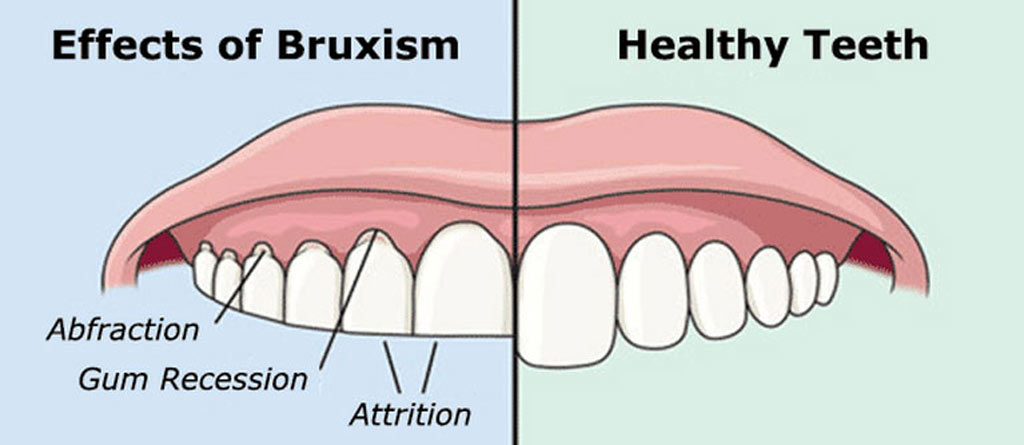 Parents are often concerned about the nocturnal grinding of teeth (bruxism). Often, the first indication is the noise created by the child grinding on their teeth during sleep. Or, the parent may notice wear (teeth getting shorter) to the dentition. One theory as to the cause involves a psychological component. Stress due to a new environment, divorce, changes at school; etc. can influence a child to grind their teeth. Another theory relates to pressure in the inner ear at night. If there are pressure changes (like in an airplane during take-off and landing, when people are chewing gum, etc. to equalize pressure) the child will grind by moving his jaw to relieve this pressure.
Parents are often concerned about the nocturnal grinding of teeth (bruxism). Often, the first indication is the noise created by the child grinding on their teeth during sleep. Or, the parent may notice wear (teeth getting shorter) to the dentition. One theory as to the cause involves a psychological component. Stress due to a new environment, divorce, changes at school; etc. can influence a child to grind their teeth. Another theory relates to pressure in the inner ear at night. If there are pressure changes (like in an airplane during take-off and landing, when people are chewing gum, etc. to equalize pressure) the child will grind by moving his jaw to relieve this pressure.
The majority of cases of pediatric bruxism do not require any treatment. If excessive wear of the teeth (attrition) is present, then a mouth guard (nightguard) may be indicated. The negatives to a mouth guard are the possibility of choking if the appliance becomes dislodged during sleep and it may interfere with the growth of the jaws. The positive is obvious by preventing wear to the primary dentition.
The good news is most children outgrow bruxism. The grinding decreases between the ages 6-9 and children tend to stop grinding between ages 9-12. If you suspect bruxism, discuss this with us at DENTAL WORKS.
Thumb Sucking
Thumb or finger sucking or pacifiers can be quite soothing to infants and young children. So while we don’t want to completely discourage your child from thumb or pacifier sucking, we also don’t want it to go on for too long, because dental or skeletal deformations may develop as a result. Therefore, your child’s thumb-sucking should stop by the time he or she is three years old. If you’re having trouble convincing your child to stop sucking his thumb, let us know at your child’s next dental checkup. We have some tips.
Pediatric Dentistry – What Is Pulp Therapy?
The pulp of a tooth is the inner, central core of the tooth. The pulp contains nerves, blood vessels, connective tissue, and reparative cells. The purpose of pulp therapy in Pediatric Dentistry is to maintain the vitality of the affected tooth (so the tooth is not lost).
Dental caries (cavities) and traumatic injury are the main reasons for a tooth to require pulp therapy. Pulp therapy is often referred to as a “nerve treatment”, “children’s root canal”, “pulpectomy” or “pulpotomy”. The two common forms of pulp therapy in children’s teeth are the pulpotomy and pulpectomy.
A pulpotomy removes the diseased pulp tissue within the crown portion of the tooth. Next, an agent is placed to prevent bacterial growth and to calm the remaining nerve tissue. This is followed by a final restoration (usually a stainless steel crown).
A pulpectomy is required when the entire pulp is involved (into the root canal(s) of the tooth). During this treatment, the diseased pulp tissue is completely removed from both the crown and root. The canals are cleansed, disinfected and, in the case of primary teeth, filled with a resorbable material. Then, a final restoration is placed. A permanent tooth would be filled with a non-resorbing material.
What Is The Best Time For Orthodontic Treatment?
Developing malocclusions, or bad bites can be recognized as early as 2-3 years of age. Often, early steps can be taken to reduce the need for major orthodontic treatment at a later age.
Stage I – Early Treatment: This period of treatment encompasses ages 2 to 6 years. At this young age, we are concerned with underdeveloped dental arches, the premature loss of primary teeth, and harmful habits such as finger or thumb sucking. Treatment initiated in this stage of development is often very successful and many times, though not always, can eliminate the need for future orthodontic/orthopedic treatment.
Stage II – Mixed Dentition: This period covers the ages of 6 to 12 years, with the eruption of the permanent incisor (front) teeth and 6-year molars. Treatment concerns deal with jaw mal-relationships and dental realignment problems. This is an excellent stage to start treatment when indicated, as your child’s hard and soft tissues are usually very responsive to orthodontic or orthopedic forces.
Stage III – Adolescent Dentition: This stage deals with the permanent teeth and the development of the final bite relationship.
Adult Teeth Coming in Behind Baby Teeth
This is a very common occurrence with children, usually the result of a lower, primary (baby) tooth not falling out when the permanent tooth is coming in. In most cases, if the child starts wiggling the baby tooth, it will usually fall out on its own within two months. If it doesn’t, then contact DENTAL WORKS, where we can easily remove the tooth. The permanent tooth should then slide into the proper place.
Tooth-Colored Fillings
In most cases, we repair a cavity with a tooth-colored filling. Made of composite resin materials, these fillings blend seamlessly with the shading of your child’s natural smile. Moreover, the material is strong, durable and requires less tooth preparation than a metal filling. That means your child spends less time with a dental drill in his or her mouth.
Dental Crowns
If tooth decay is so severe that a filling will not do, then a dental crown may be the best solution. A crown may also be called for in case of an injury that damages a tooth. A crown, which can be made of porcelain, metal or ceramics, completely covers a tooth. The doctor will prepare the tooth by removing decay and contouring the tooth. Then, the customized crown is cemented into place.
Root Canal Therapy
For an infected tooth, root canal therapy may be necessary. Please don’t think that your child will be in pain during a root canal. To the contrary, a root canal is designed to eliminate the pain of an infected tooth. With special tools, Doctor accesses the tooth’s innermost pulp chamber to remove the infection and replace it with a biocompatible material. The dentist completes the treatment with a protective dental crown.
Schedule an Appointment Today
Early Infant Oral Care
Perinatal & Infant Oral Health
All pregnant women receive oral healthcare and counseling during pregnancy. Research has shown evidence that periodontal disease can increase the risk of preterm birth and low birth weight. Talk to us at DENTAL WORKS about ways you can prevent periodontal disease during pregnancy.
Additionally, mothers with poor oral health may be at a greater risk of passing the bacteria which causes cavities to their young children. Mother’s should follow these simple steps to decrease the risk of spreading cavity-causing bacteria:
1. Visit your dentist regularly.
2. Brush and floss on a daily basis to reduce bacterial plaque.
3. Proper diet, with the reduction of beverages and foods high in sugar & starch.
4. Use a fluoridated toothpaste recommended by the IDA and rinse every night with an alcohol-free, over-the-counter mouth rinse with .05 % sodium fluoride in order to reduce plaque levels.
5. Don’t share utensils, cups or food which can cause the transmission of cavity-causing bacteria to your children.
6. Use of xylitol chewing gum (4 pieces per day by the mother) can decrease a child’s caries rate.
When Will My Baby Start Getting Teeth?
Teething, the process of baby (primary) teeth coming through the gums into the mouth, is variable among individual babies. Some babies get their teeth early and some get them late. In general, the first baby teeth to appear are usually the lower front (anterior) teeth and they usually begin erupting between the age of 6-8 months.
Baby Bottle Tooth Decay (Early Childhood Caries)
One serious form of decay among young children is baby bottle tooth decay. This condition is caused by frequent and long exposures of an infant’s teeth to liquids that contain sugar. Among these liquids are milk (including breast milk), formula, fruit juice, and other sweetened drinks.
Putting a baby to bed for a nap or at night with a bottle other than water can cause serious and rapid tooth decay. Sweet liquid pools around the child’s teeth giving plaque bacteria an opportunity to produce acids that attack tooth enamel. If you must give the baby a bottle as a comforter at bedtime, it should contain only water. If your child won’t fall asleep without the bottle and its usual beverage, gradually dilute the bottle’s contents with water over a period of two to three weeks.
After each feeding, wipe the baby’s gums and teeth with a damp washcloth or gauze pad to remove plaque. The easiest way to do this is to sit down, place the child’s head in your lap or lay the child on a dressing table or the floor. Whatever position you use, be sure you can see into the child’s mouth easily.
Sippy Cups
Sippy cups should be used as a training tool from the bottle to a cup and should be discontinued by the first birthday. If your child uses a sippy cup throughout the day, fill the sippy cup with water only (except at mealtimes). By filling the sippy cup with liquids that contain sugar (including milk, fruit juice, sports drinks, etc.) and allowing a child to drink from it throughout the day, it soaks the child’s teeth in cavity-causing bacteria.
Prevention
How to Care for Your Child’s Teeth
Children’s dentistry actually begins with you. Even before your child has any teeth, dental care is important. Those beautiful pearly whites are just waiting to erupt through the gums. So, after every feeding, be sure to wipe your baby’s gums with a soft, damp washcloth. This will remove plaque and any formula or breastmilk. If you are bottle-feeding, don’t let your baby fall asleep with a bottle of milk or juice, which both contain sugars that can cause cavities to develop.
Once that first little tooth arrives, it’s time to start brushing. Use a soft baby toothbrush that is moistened with water. There’s no need to use toothpaste yet. As your child grows and more teeth erupt, you can add a minimal amount of fluoride toothpaste.
Try to minimize the amount of toothpaste your child swallows. If your child is too young to spit, then just smear a small amount of toothpaste on the brush. As they learn to spit, you can use a pea-size amount of toothpaste. You’ll need to help your children brush and floss at least until they are seven or eight years old. When they start brushing and flossing on their own, they still might need your help. They should brush their teeth at least two times each day. Very often, toothpaste for adults contains abrasives that can be damaging to developing teeth. Flossing should happen every night before bed and may need supervision longer than brushing.
In keeping with the recommendation of the Indian Academy of Pediatric Dentistry, we would like to begin seeing your children for regular checkups on or before their first birthdays. Starting this young, your children will become accustomed to seeing the dentist and will begin a lifelong foundation of dental health care.
Nutrition Advice from DENTAL WORKS Children’s Dentist
Just as the rest of your children’s growing bodies need good nutrition to develop, so do their teeth. A nutritious and well-balanced diet is required for healthy teeth and gums. Ideally, your child’s daily diet should include one or more servings of milk, fruits, vegetable, meat or beans, grains, and essential oils.
For more information about your child’s oral health, or to schedule an appointment, call at DENTAL WORKS.
Pediatric Dentistry – How Do I Prevent Cavities?
Good oral hygiene removes bacteria and the leftover food particles that combine to create cavities. For infants, use a wet gauze or clean washcloth to wipe the plaque from teeth and gums. Avoid putting your child to bed with a bottle filled with anything other than water.
For older children, brush their teeth at least twice a day. Also, watch the number of snacks containing sugar that you give your children.
Your pediatric dentist may also recommend protective sealants or home fluoride treatments for your child. Sealants can be applied to your child’s molars to prevent decay on hard to clean surfaces.
Seal Out Decay
A sealant is a protective coating that is applied to the chewing surfaces (grooves) of the back teeth (premolars and molars), where four out of five cavities in children are found. This sealant acts as a barrier to food, plaque, and acid, thus protecting the decay-prone areas of the teeth.
Before Sealant Applied
After Sealant Applied
Fluoride Treatments and Dental Sealants
Fluoride is a natural mineral that attracts other minerals and thereby strengthens tooth enamel. In addition, fluoride inhibits the growth of bacteria that can cause a cavity. Therefore, we may recommend fluoride treatments. On the other hand, too much fluoride can be harmful to your children’s smiles. With too much fluoride in their diets, children can develop fluorosis, which causes white spots or streaks to develop on their teeth. In severe cases, tooth enamel may turn brown. To prevent fluorosis, make sure your children do not swallow fluoridated toothpaste. Until you know they can spit, either eliminate toothpaste or use a very small amount.
Dental sealants form a solid layer of protection on top of your children’s molars to help them in the battle against tooth decay. Sealants start out as a liquid plastic that we “paint” on the chewing surface of your children’s teeth. Once dried with a curing light, sealants are a barrier between the bacteria that cause cavities and your children’s deeply grooved and pitted molars.
Mouth Guards
Whether a child is engaging in collision sports such as hockey and football or simply part of a dance class or track team, acrylic mouth guards protect young mouths from soft tissue lacerations, chronic teeth clenching and grinding, tooth avulsion, chips, and cracks. The stability and strength conferred by a mouthguard also reduce the chances of jaw fracture and dislocation.
Formed from BPA-acrylic according to oral impressions taken at DENTAL WORKS, a sports mouthguard takes an impact so a child’s teeth, gums, and jaw don’t have to. Mouthguards protect better and are more comfortable than store-bought appliances.
Gum dentistry (periodontics)
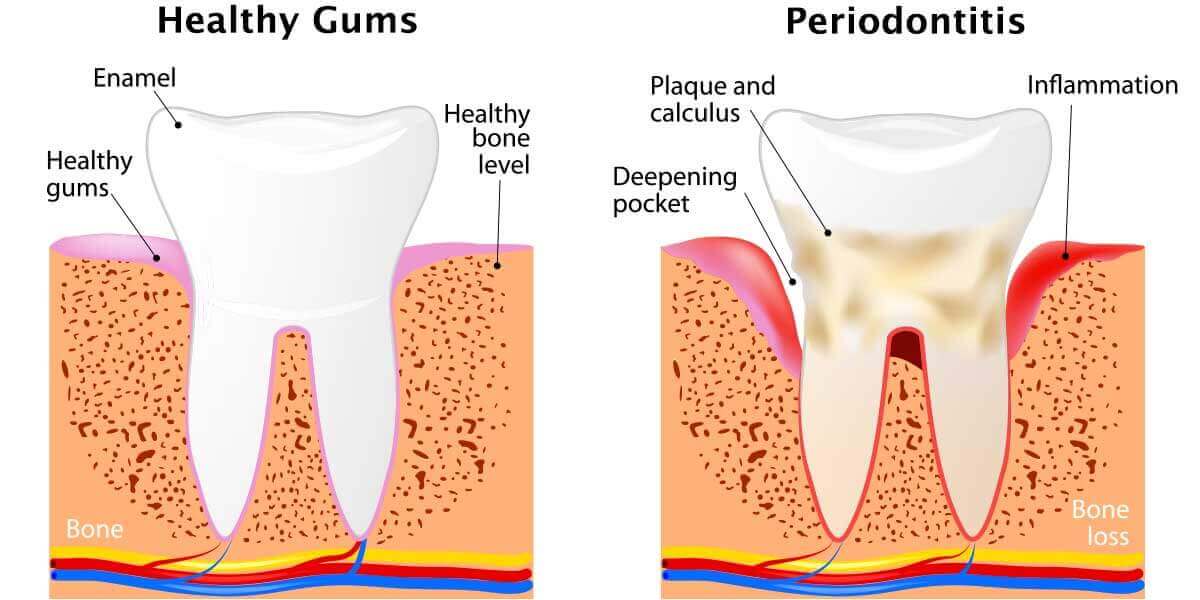
Periodontal Therapy
What Is Periodontitis?
 Periodontitis is an infection of the bone and gums which surround the teeth. It is caused by the bacteria which normally reside in your mouth. When the bacteria become more numerous than normal, or at a level which your body can not tolerate, an inflammatory reaction takes place and your body begins to destroy the bone which supports the teeth. When the bacteria in your mouth cause bone loss, the gum tissue does not always recede away with the lost bone. Pockets are created which harbor more bacteria and are unreachable with a normal toothbrush and floss. The deep pockets perpetuate the cycle of bone loss. The teeth subsequently become loosened, and if not treated in a timely manner, the teeth can even be lost.
Periodontitis is an infection of the bone and gums which surround the teeth. It is caused by the bacteria which normally reside in your mouth. When the bacteria become more numerous than normal, or at a level which your body can not tolerate, an inflammatory reaction takes place and your body begins to destroy the bone which supports the teeth. When the bacteria in your mouth cause bone loss, the gum tissue does not always recede away with the lost bone. Pockets are created which harbor more bacteria and are unreachable with a normal toothbrush and floss. The deep pockets perpetuate the cycle of bone loss. The teeth subsequently become loosened, and if not treated in a timely manner, the teeth can even be lost.
During this process, there can be a foul odor from the mouth, as well as infection (pus) coming from the gums. But this process is usually painless and can sometimes go unnoticed for quite some time until significant symptoms, such as bad breath or loose teeth, indicate a problem.
Periodontitis – Non-Surgical Therapy
Nearly all forms of periodontitis are treated initially in a non-surgical manner. This is due to the nature of the cause of periodontitis. As mentioned before, the bacteria that are naturally in the mouth can overpopulate in the form of dental soft plaque and hard calculus if the teeth are not properly cleaned on a sally basis. The bacterial toxins that result can cause destruction and inflammation initially of the soft tissues and gums around the teeth as shown in the picture below. As the disease progresses, the bone is also affected. If the disease is left unchecked, the teeth can potentially be lost. As the bacteria in the form of. plaque is the cause of periodontal disease, their gross removal and reduction is the first step in the termination of this process. This removal takes place in the form of scaling and root planing.
Before treatment
Scaling and Root Planing
 Scaling and root planning involves the use of a special ultrasonic device with water irrigation to cleanse the pockets of plaque and debris and remove hard calculus deposits. A local anesthetic is also used to numb the area to be treated in order to reach the base of the pocket without causing you discomfort during treatment. You can also bring along an iPod to help you relax. Usually, the treatment of the entire mouth takes place one quadrant of the mouth treated at a time. This should reduce inflammation and reduce pocket depths by allowing your gum tissue to re-attach to the tooth root surface. It is not unusual to experience some soreness in the treated area. Temperature sensitivity may also be a side-effect of the treatment and should resolve in a few weeks. If it does not, other treatments are available to reduce this sensitivity. Finally, recession after treatment is normal since the swelling for of the infected gum tissue is reduced after therapy.
Scaling and root planning involves the use of a special ultrasonic device with water irrigation to cleanse the pockets of plaque and debris and remove hard calculus deposits. A local anesthetic is also used to numb the area to be treated in order to reach the base of the pocket without causing you discomfort during treatment. You can also bring along an iPod to help you relax. Usually, the treatment of the entire mouth takes place one quadrant of the mouth treated at a time. This should reduce inflammation and reduce pocket depths by allowing your gum tissue to re-attach to the tooth root surface. It is not unusual to experience some soreness in the treated area. Temperature sensitivity may also be a side-effect of the treatment and should resolve in a few weeks. If it does not, other treatments are available to reduce this sensitivity. Finally, recession after treatment is normal since the swelling for of the infected gum tissue is reduced after therapy.
One week after cleaning the left side
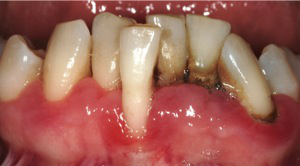 Of vital importance in the treatment of periodontitis is the patient’s responsibility in maintaining proper oral hygiene in between dental visits. Without proper oral hygiene as performed by the patient, the success of therapy is greatly reduced.
Of vital importance in the treatment of periodontitis is the patient’s responsibility in maintaining proper oral hygiene in between dental visits. Without proper oral hygiene as performed by the patient, the success of therapy is greatly reduced.
Sometimes, scaling and root planning is all that is needed to control the disease process, and a regular schedule of maintenance cleanings is necessary to monitor any change in disease activity through changes in pocket depth. If the pocket depths continue to progress or are not resolved with initial scaling and root planning, surgery may be necessary to correct the loss of bone and resultant pocketing.
Gum / flap surgeries
Gum diseases have to be evaluated and treated at the earliest in order to protect the teeth and oral function. Our team of highly skilled Periodontists specialize in providing you the most advanced gum care.
Gingival Flap surgeries are aimed at disinfecting the Periodontal tissues and making them regain health. Such treatments enhance the life of the teeth and Surrounding bone, and this makes your gums sterile and completely free of harmful bacteria.
Usually assisted with lasers gum surgeries will keep your oral tissues disinfected for a long time. The gums are cleaned with highly specialized instruments. The concerned area is numbed with local anaesthesia so that the entire process will be pain-free for you. The gums are elevated carefully. The granulation tissue which contains active microbes is then removed. The tooth and root surface is also cleaned at the same time. By doing so, both the hard and soft tissue are disinfected perfectly and this makes your gums free from harmful bacteria.
Depending on the level of destruction, you may or may not require soft tissue or hard tissue grafting.
Frenectomy
With a high placed frenum, people have a certain midline gap which looks unaesthetic. The muscle tissue is interposed between two central teeth and moves when you eat drink or even speak – creating that gap which increases with the age – if not treated early. With specially assisted lasers we re-position the muscle tissue. A quick 20 min procedure and you can get the gap closed with any of our cosmetic option or the orthodontic options.
Wisdom teeth extractions
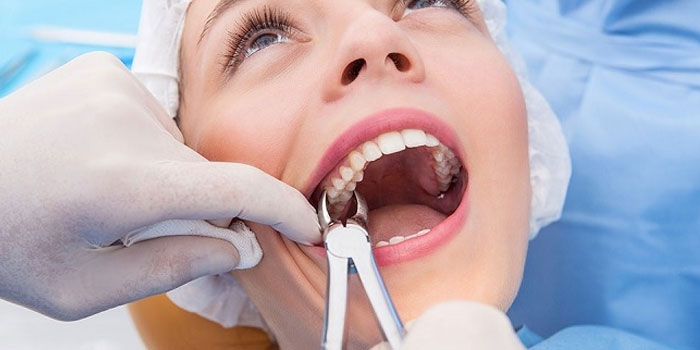
Wisdom Tooth Extraction in Delhi
Wisdom teeth are the last teeth to develop in our jaw and they come through at the back of the mouth behind the last standing teeth.
If you’re told that your wisdom teeth are “impacted”, it means that there is not enough space for them to grow into the jaw in a normal position or when they erupt at an angle or in an unexpected location. The Dental Works is a Speciality Centre when it comes to tooth extraction in Delhi.
What is wisdom tooth removal?
Wisdom tooth extraction is a surgical procedure to remove one or more wisdom teeth. At The Dental Works, our main goal is to preserve and keep your natural teeth strong and healthy for life. It is a multi-specialty centre in Delhi. The team has specialized Oral and Maxillofacial Surgeons who perform all procedures in dealing with conditions related wisdom tooth extraction and other jaw related disorders.
What are the symptoms?
 Impacted teeth won’t cause any problem to some patients, while others might show obvious symptoms. Keeping a partially impacted wisdom tooth clean is difficult, they can also cause food to become trapped which can lead to tooth decay. For some people, a partially impacted tooth is very painful. If the tooth becomes infected or causes other issues, you may have symptoms such as:
Impacted teeth won’t cause any problem to some patients, while others might show obvious symptoms. Keeping a partially impacted wisdom tooth clean is difficult, they can also cause food to become trapped which can lead to tooth decay. For some people, a partially impacted tooth is very painful. If the tooth becomes infected or causes other issues, you may have symptoms such as:
- Pain or swelling around the jaw
- Red, swollen, or bleeding gums
- Bad breath
- An unpleasant taste in your mouth
- Problems opening your mouth
In other cases, the affected tooth may never break through the gums. This is known as a fully impacted wisdom tooth.
What causes an impacted wisdom tooth?
Mostly, wisdom teeth become impacted because it is the last tooth to enter the oral cavity and by then your jaw doesn’t have enough space for it to emerge. Sometimes, partial impaction is seen when the tooth grows in a wrong direction.
How is an impacted wisdom tooth diagnosed?
X-rays and thoroughly examination of your mouth is done before making a treatment plan. An X-ray shows whether your teeth are impacted and if it has damaged other teeth and bone. If your teeth are impacted, your dentist is going to discuss with you the benefits and risks of surgical extraction.
How are impacted wisdom teeth treated?
If your impacted wisdom teeth cause symptoms or dental problems, your dentist may suggest a surgical extraction which is usually an outpatient procedure. You can go home the same day. As part of the procedure, your doctor may use anesthetic drugs to induce a type of anesthesia, such as:
- local anesthesia to numb your mouth
- sedation anesthesia to relax you and block pain
- general anesthesia to make you sleep and not feeling anything during the procedure
The entire surgery usually takes about 30 to 60 minutes. Sometimes the procedure may take longer time if the tooth is completely impacted and buried within your gums or jawbone.
Occasionally after the procedure a suture is placed that helps in healing. An ice pack is been provided by the clinic for decreasing the post extraction swelling.
Recovering from wisdom tooth extraction
Most people can get back to their normal activities a few days after surgery. It takes up to six weeks for your mouth to completely heal.For about a 4 to 5 days, soft food will be suggested by the dentist.
After surgery, you may experience some pain, bleeding, and swelling. Your doctor will give you specific instructions for managing discomfort, such as taking pain medications and using cold compresses.
Although rare, you may develop a painful dry socket. This happens when the blood clot that’s supposed to form after surgery doesn’t form properly or becomes dislodged from the socket and exposes bone. In such cases you are advised to visit your dentist as soon as possible.
Wisdom Teeth Treatment in Delhi
At The Dental Works, we do not advise wisdom tooth extraction if they are correctly positioned and do not cause any discomfort. However if there is impaction or crowding, our dentist may recommend a wisdom tooth extraction. Tooth Extraction Surgery is a mostly is single sitting session which is carried out under a local anaesthesia to ensure painless treatment. For your Wisdom Tooth Extraction in Delhi at our clinic, The Dental Works, you be treated by a dedicated Oral and Maxillofacial Surgeon. Our Oral Surgeons specialize in diagnosis and treatments of diseases, disorders, injuries, defects and aesthetic attributes of teeth, jaws, mouth, face & neck. The treatment is virtually painless and our team ensures you are most comfortable through out. The dentist will guide you through the post treatment care instructions to ensure speedy recovery. Contact The Dental Works for tooth extraction in Delhi.


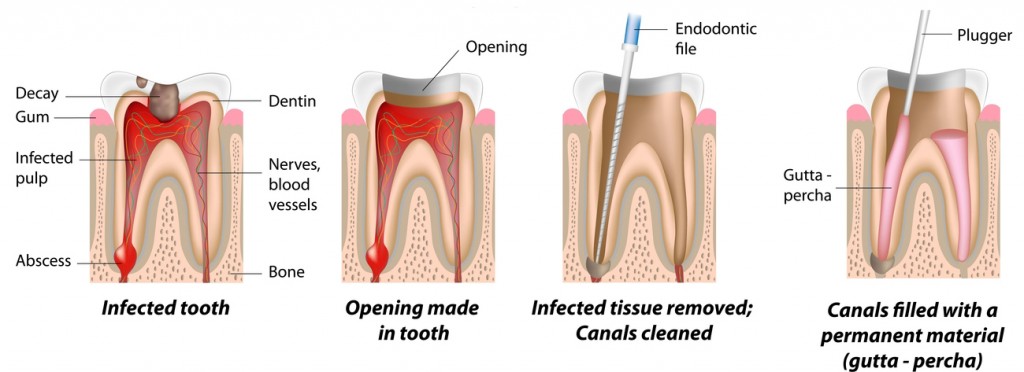
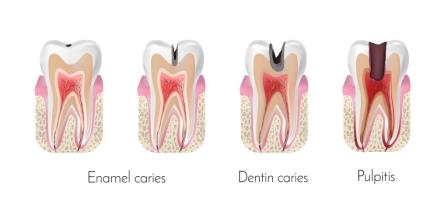
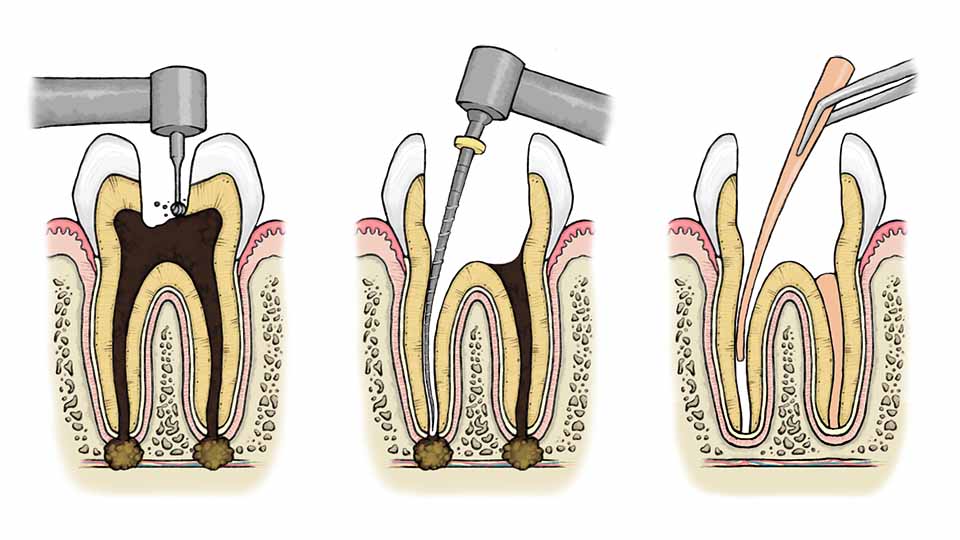
 Immediately after the root canal treatment, the area around the tooth may be sore, so you may want to avoid biting down or using that tooth. In general, though, you can care for your tooth like any other tooth, with regular brushing and flossing.
Immediately after the root canal treatment, the area around the tooth may be sore, so you may want to avoid biting down or using that tooth. In general, though, you can care for your tooth like any other tooth, with regular brushing and flossing.


































